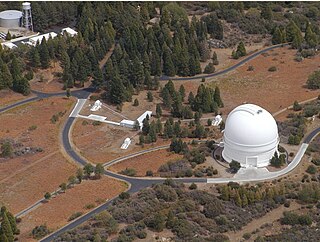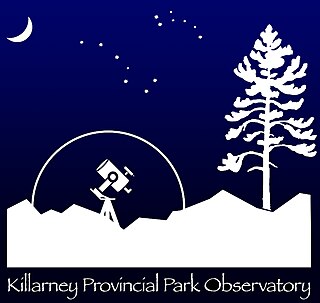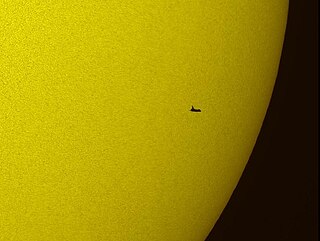Related Research Articles

Amateur astronomy is a hobby where participants enjoy observing or imaging celestial objects in the sky using the unaided eye, binoculars, or telescopes. Even though scientific research may not be their primary goal, some amateur astronomers make contributions in doing citizen science, such as by monitoring variable stars, double stars, sunspots, or occultations of stars by the Moon or asteroids, or by discovering transient astronomical events, such as comets, galactic novae or supernovae in other galaxies.

Astrophotography, also known as astronomical imaging, is the photography or imaging of astronomical objects, celestial events, or areas of the night sky. The first photograph of an astronomical object was taken in 1840, but it was not until the late 19th century that advances in technology allowed for detailed stellar photography. Besides being able to record the details of extended objects such as the Moon, Sun, and planets, modern astrophotography has the ability to image objects outside of the visible spectrum of the human eye such as dim stars, nebulae, and galaxies. This is accomplished through long time exposure as both film and digital cameras can accumulate and sum photons over long periods of time or using specialized optical filters which limit the photons to a certain wavelength.

Palomar Observatory is an astronomical research observatory in San Diego County, California, United States, in the Palomar Mountain Range. It is owned and operated by the California Institute of Technology (Caltech). Research time at the observatory is granted to Caltech and its research partners, which include the Jet Propulsion Laboratory (JPL), Yale University, and the National Astronomical Observatories of China.

Stardome Observatory is a public astronomical observatory situated in Maungakiekie/One Tree Hill Domain in Auckland, New Zealand.

A robotic telescope is an astronomical telescope and detector system that makes observations without the intervention of a human. In astronomical disciplines, a telescope qualifies as robotic if it makes those observations without being operated by a human, even if a human has to initiate the observations at the beginning of the night or end them in the morning. It may have software agents using artificial intelligence that assist in various ways such as automatic scheduling. A robotic telescope is distinct from a remote telescope, though an instrument can be both robotic and remote.
Terence Dickinson was a Canadian amateur astronomer and accomplished astrophotographer who lived near Yarker, Ontario, Canada. He was the author of 14 astronomy books for both adults and children. He was the founder and former editor of SkyNews magazine. Dickinson had been an astronomy commentator for Discovery Channel Canada and taught at St. Lawrence College. He made appearances at such places as the Ontario Science Centre. In 1994, the International Astronomical Union committee on Minor Planet Nomenclature named asteroid 5272 Dickinson in honour of his “ability to explain the universe in everyday language.”

An astrograph is a telescope designed for the sole purpose of astrophotography. Astrographs are mostly used in wide-field astronomical surveys of the sky and for detection of objects such as asteroids, meteors, and comets.

Astronomy is a monthly American magazine about astronomy. Targeting amateur astronomers, it contains columns on sky viewing, reader-submitted astrophotographs, and articles on astronomy and astrophysics for general readers.
James Whitney Young is an American astronomer who worked in the field of asteroid research. After nearly 47 years with the Jet Propulsion Laboratory at their Table Mountain Facility, Young retired July 16, 2009.
Astronomy Now is a monthly British magazine on astronomy and space. According to the Royal Astronomical Society, Astronomy Now is the "principal amateur astronomy magazine in Britain" with a reputed circulation of 24,000.
Paul Boltwood was a Canadian amateur astronomer. He was engaged in developing hardware and software for deep sky imaging and in research of brightness variations in active galactic nuclei. He was also acknowledged for his studies of near-nucleus activity in Comet Hyakutake.

Nicholas Szymanek, better known as Nik Szymanek, is a British amateur astronomer and prolific astrophotographer, based in Essex, England.
LightBuckets is a commercial astronomical observatory formerly located in Rodeo, New Mexico and now located in France, which rents time on its telescopes to customers around the world via a website on the Internet, including amateur and professional astronomers. It is an online astronomy platform with live-views, and hosts an image gallery of astronomy images. Recognized scientific uses include the confirmation of supernova and discovery of asteroids.

Puckett Observatory is a private astronomical observatory located in the state of Georgia. It is owned and operated by Tim Puckett. Its primary observation goals are the study of comets and the discovery of supernovae. To facilitate the latter goal it sponsors the Puckett Observatory World Supernova Search whose astronomers have discovered 369 supernovae.
Steve Mandel is an amateur astronomer and astrophotographer. He owns a small observatory, called Hidden Valley Observatory, in Soquel, California. He has been acknowledged especially for his wide-field photographs of the Milky Way nebulae and for public outreach, for which he has received Amateur Achievement Award of the Astronomical Society of the Pacific. Besides this he has also captured and published wildlife images of endangered animals. He works as an American communications coach for professional executives, and is the founder of the Mandel Communications Inc., which aims to teach effective communication and public speaking.

Robert Gendler is an American physician, amateur astronomer, author and astrophotographer.

The Killarney Provincial Park Observatory is an astronomical observatory located at the George Lake Campground of Killarney Provincial Park . The Observatory is operated by Ontario Parks and houses two observatory buildings. The original facility contains a 10" telescope with solar filter, ideal for nighttime as well as daytime viewing of the Sun. The newer facility contains a 16" fully automated telescope with a 5" refractor and is ideal for research, astrophotography and public use. The telescopes are available for Discovery programs as well as private sign-out (self-use) by interested visitors.

Robert Jay GaBany is an American amateur astronomer and astrophotographer who is also known for his work with an international team of astrophysicists led by Dr. David Martínez-Delgado. GaBany helped pioneer the use of modest size telescopes and off the shelf CCD-cameras to produce long exposure images that revealed ancient galactic merger remnants in the form of star streams surrounding nearby galaxies that were previously undetected or suspected.

Thierry Legault is a French amateur astronomer, specializing in astrophotography.

Dylan O'Donnell is an Australian IT entrepreneur and amateur photographer, whose astrophotography has been featured by the European Space Agency (ESA), and NASA. His work has been selected twice for NASA's Astronomy Picture of the Day (APOD).
References
- ↑ "Explore Alliance Astrophotography Ambassadors - Jack Newton". Explore Scientific . Retrieved 4 December 2022.
- ↑ "cover of Astronomy Magazine, Feb 1992 - Jack Newton". Astronomy Magazine . Retrieved 4 December 2022.
- 1 2 "Jack Newton (1942- )". AstroLAB, Mont-Mégantic National Park . Retrieved 22 December 2014.
- ↑ "30840 Jackalice (1991 GC2)". JPL Small-Body Database Browser. Jet Propulsion Laboratory.
- ↑ "Puckett Observatory list of supernova". www.astronomyatlanta.com. June 23, 2013. Retrieved September 18, 2017.
- ↑ "Chant Medal".
- ↑ "Looking Up, a History of the Royal Astronomical Society of Canada, page 61" (PDF).
- ↑ "Jack Newton's 'Journey to the Stars' (video)". 2023. Retrieved 9 October 2023.
- ↑ "Osoyoos Observatory Bed & Breakfast offers tours of the Universe". Canadian Nature Photographer magazine. Retrieved 4 December 2022.